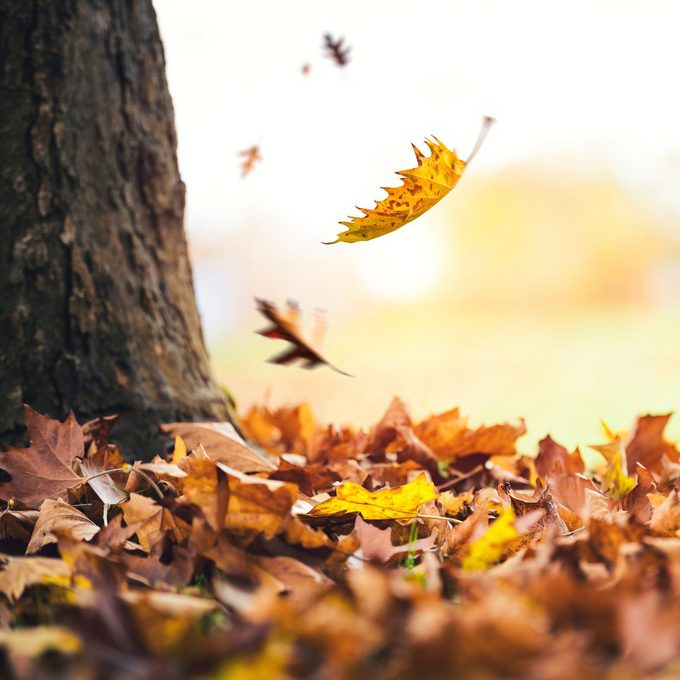If Your Leaves Aren’t Changing Colors This Fall, This Is What It Means
Depending on where you live, the fall foliage situation might be a little different this year. We’re talking about leaves changing color and/or falling later than usual, or even falling off of trees without changing color much at all.
If your typical fall routine involves spending breezy autumn afternoons enjoying the tree scene in all its splendor, what you’re seeing is probably disappointing. And what about all those fall lawn care chores you normally work into your weekend schedule? Should you even bother getting out your rake?
Yes, because the leaves are probably still going to change color and fall off the trees — eventually. The delay, though, will impact when you do those chores.
Where Is This Happening? And Why?
If you’re looking out the window and wondering what we’re talking about (because your lawn could actually use a good raking), you probably live in the Pacific Northwest, or maybe the Midwest. The leaves are pretty much right on schedule in these areas. But if you live in New Hampshire, Vermont or certain Southern areas? Not so much.
“We’ve seen a delay in fall leaf color in 2021 across much of the Northeastern U.S. and higher elevations of the South, largely due to higher than average temperatures during later summer and early fall,” says Steve Norman, Ph.D., a research ecologist with the U.S. Forest Service.
Along with the heat, heavy rain can also impact the color patterns of leaves, Norman says. (We probably don’t need to tell you about all the rain this year in some areas, with more to come.) This is because wet leaves are prone to fungal infections. While fungus-infected leaves will turn brown and fall off, Norman says they won’t exhibit strong displays of color.
What Does This Mean For the Health of Your Trees?
Don’t let this worry you too much, at least not in the short term. “If leaves stay green a little longer than normal, that isn’t much of a tree health concern,” Norman says.
The exception to this, he adds, might be trees in colder places, or those at higher elevations. If a severe winter storm comes through before trees have shed their leaves, the extra-heavy branches could break under the weight of snow and ice.
And if excessive heat and heavy rains keep happening, impacting the “schedule” of leaves year after year? That’s a much bigger concern than a one-off drought, says Chris Still, a professor of Forest Ecology at Oregon State University. Over time, Still says, it’s possible lots of excessive heat will impact the growth of trees.
“(This is) a bad scenario if it keeps happening,” Still says. “(It’s) bad for plants and people. They don’t do well in extremes.”
Does This Change How I Handle Leaf Raking This Fall?
Of course, as individuals we can’t do much about the weather. And we definitely can’t tell our trees when to shed their leaves. What we can do, though, is adapt to whatever it is the weather and our trees decide to do.
Kris Kiser, president of the TurfMutt Foundation, an environmental education and stewardship organization, recommends looking at the delay as an opportunity to spend extra time caring for your yard and preparing for the upcoming winter and spring.
“If leaves change color later, that means that homeowners have more time to do fall lawn tasks and check off their to-do list,” Kiser says.
While you’re waiting around to rake, you can aerate your lawn if you haven’t already. This will help produce a lush lawn come spring, says Kiser. You can also continue mowing. You can fertilize, and maybe even plant some grass seed. Always be careful not to run over the tree roots or nip the trunk with your outdoor power equipment.
When the leaves do finally do start falling?

“Give (your trees) one last deep watering before the ground gets too hard to allow water to get to the roots,” Kiser says. Then, get out there with your rake or leaf blower!
It’s important to get the leaves off your lawn before it rains or snows because a thick mat of leaves isn’t good for the grass. You definitely want to avoid raking wet leaves. Here’s what to do with those leaves after they’ve been raked.
This is also a good time to put mulch around trees, which will help them survive the upcoming cold winter temperatures, Kiser says. A lot of work, yes. But in the end, it’s worth it if it keeps your trees in good shape.
“Trees add a lot of value to your landscape and even benefit your health, so it is important to take care of them,” says Kiser. He referenced a 2015 study that found people who live on streets with more trees had better heart and metabolic health.
No comments